
 |
|
#21
|
|||
|
|||
|
Seriously tho guys, the Tempest isnt what I would call an 'easy flier' when compared to, for example, the Me109F4, The La5 or the Spifire IX.
It feels very much like a Corsair to me, that big heavy nose which you have to 'haul' around in a turn. Also its not totally stable as a gun platform, the nose wobbles for me quite a bit, I presume because the engine is so heavy as with the Corsair. However the 'instability' not as critical as with the corsair with 50 cals, because a couple of 20mm Hispano hits can damage an enemy good, whereas the Corsair needs more than a 'passing shot' with the 50's to get the enemy down. IL2 in my opinon does a good job of modelling hte big heavy radial in the Corsair and the massive Sabre engine in the Tempest. You can really 'feel' the weight in the nose as you haul them around. They are certainly not as nice feeling as a very much lighter 109E/F/G2, SPitfire IX or La5FN for example. Its a bit like a Sports Car built for corners, compared to a Dragster with massive engine made for straight lines. |
|
#22
|
|||
|
|||
|
Salute
The Tempest we have in the game is the earliest production model of the aircraft, one which only operated in early 1944, during April and June, and which was replaced by more powerful models. It represents about 10% of the Tempests which flew. It is a far cry from the Tempests which flew in 1945. To use a comparison, imagine if there was only one 190A in the game, and that was the 190A4. Second, the handling of the Tempest is questionable. The combat reports I have read, from both Allied and German pilots, suggest it could easily outturn the 190D at its normal operating speeds. (see "JG26, TOP GUNS OF THE LUFTWAFFE" the last part of the book, for several quotes from German pilots who encountered the Tempest) The Tempest had a wingloading of 37 lbs per Sq/ft, compared with 48 lbs per Sq/ft for the 190D, even if you take into account the fact that the Tempest had a laminar flow aerofoil, the 23% better wingloading has to be a factor. Official RAF AIR FIGHTING DEVELOPMENT UNIT tests of the initial prototype Tempest versus the 109G2, showed it outturned the G2, and the prototype had less horsepower than the version we have. |
|
#23
|
||||
|
||||
|
Yet Clostermann in his book hints that the Tempest was pretty close to a deathtrap and scared the crap out of most pilots.
|
|
#24
|
|||
|
|||
|
Quote:
"Reaching Newchurch airfield at 480 mph I held "RB" down to 20 ft from the runway and then pulled her up to a 60 ° climb holding it as the speed dropped slowly off and the altimeter needle spun round the dial as if it were mad. At 7000 ft the speed was dropping below 180 mph and I rolled the Tempest lazily inverted, then allowed the nose to drop until the horizon, at first above my head, disappeared below (or rather above) the now inverted nose, the fields and woods steadied into the centre of the windscreen and then whirled around as I put the stick hard over and rolled around the vertical dive. Steadying again I pulled out over the tree tops at 500 mph, throttled back and pulled hard over towards the airfield in an over-the-vertical climbing turn, lowering the wheels and flaps in a roll as the speed dropped. What a magnificent aeroplane! They could have all their Spitfires and Mustangs!" quote from Roland Beaumont, the RAF Squadron Leader who had the most experience with the Tempest of any pilot. RAF Tempest Squadrons from January 1945 of the war were given carte blanche to go anywhere, engage anyone, at whatever odds, because they were confident of the aircraft's ability to deal with any situation. Other RAF pilots were envious of the complete freehand the Tempest pilot's got. The combat record of the Tempest was exceptional, it had a very large positive in the kill/death ratio, even when claims are compared to German records. That includes encounters with Doras. Last edited by *Buzzsaw*; 01-23-2008 at 12:37 AM. |
|
#25
|
|||
|
|||
|
Pierre Clostermann (Free French) wrote of the Tempest:
Nothing was left undone to give the Tempest a maximum performance at medium and low altitudes. Special auxiliary tanks were designed even, with perspex connecting pipes, to fit under the wings. Quite extraordinary attention was paid to the rivetting, the joints and the surface polish. The result was a superb combat machine. It had a thoroughbred look and, in spite of the big radiator which gave it an angry and wilful appearance, it was astonishingly slender. It was very heavy, all of seven tons. Thanks to its 2,400 h.p. engine it had a considerable margin of excess power and its acceleration was phenomenal. It was pretty tricky to fly, but its performance more than made up for it: at 3,000 feet, at economical cruising on one third power (950 h.p.) with two 45-gallon auxiliary tanks, 310 m.p.h. on the clock, i.e. a true air speed of 320 m.p.h.; at fast cruising speed, at half power (1,425 h.p.) without auxiliary tanks, 350 m.p.h. on the clock, i.e. a true air speed of nearly 400 m.p.h.; Maximum speed straight and level with + 13 boost and 3,850 revs.: 430 m.p.h. on the clock, i.e. a true airspeed of 440 m.p.h. In emergencies you could over-boost it up to nearly 3,000 h.p. and 4,000 revs., and the speed went up to 460 m.p.h. In a dive the Tempest was the only aircraft to reach, without interfering with its handling qualities to any marked extent, subsonic speeds, i.e. 550-600 m.p.h. Tempest V. Messerschmitts: I kept on reminding my pilots to keep their speed above 300 m.p.h., for "109's" could turn better than we could at low speed, and you had to watch out for the 30 mm. cannon in their propeller - it didn't give you a second chance. The best technique was to do a spiral dive, work up to a speed of 450 m.p.h., do a straight climb and then start all over again. The "109's" on the other hand, knowing that we dived faster than they did, tried to get us up to 16,000 feet, where our Tempests were heavy and our engines sluggish. Our Tempest: Second production batch of 300 aircraft built by Hawker Aircraft Ltd, Langley, Buckinghamshire. EJ504, EJ518-EJ560, EJ577-EJ611, EJ626-EJ672, EJ685-EJ723, EJ739-EJ788, EJ800-EJ846, EJ859-EJ896. Series 2 aircraft, Sabre IIA engines, short-barrel cannon, spring tab ailerons. Deliveries commenced 5-44, completed 9-44; average rate of production approximately 18 aircraft per week. |
|
#26
|
|||
|
|||
|
Quote:
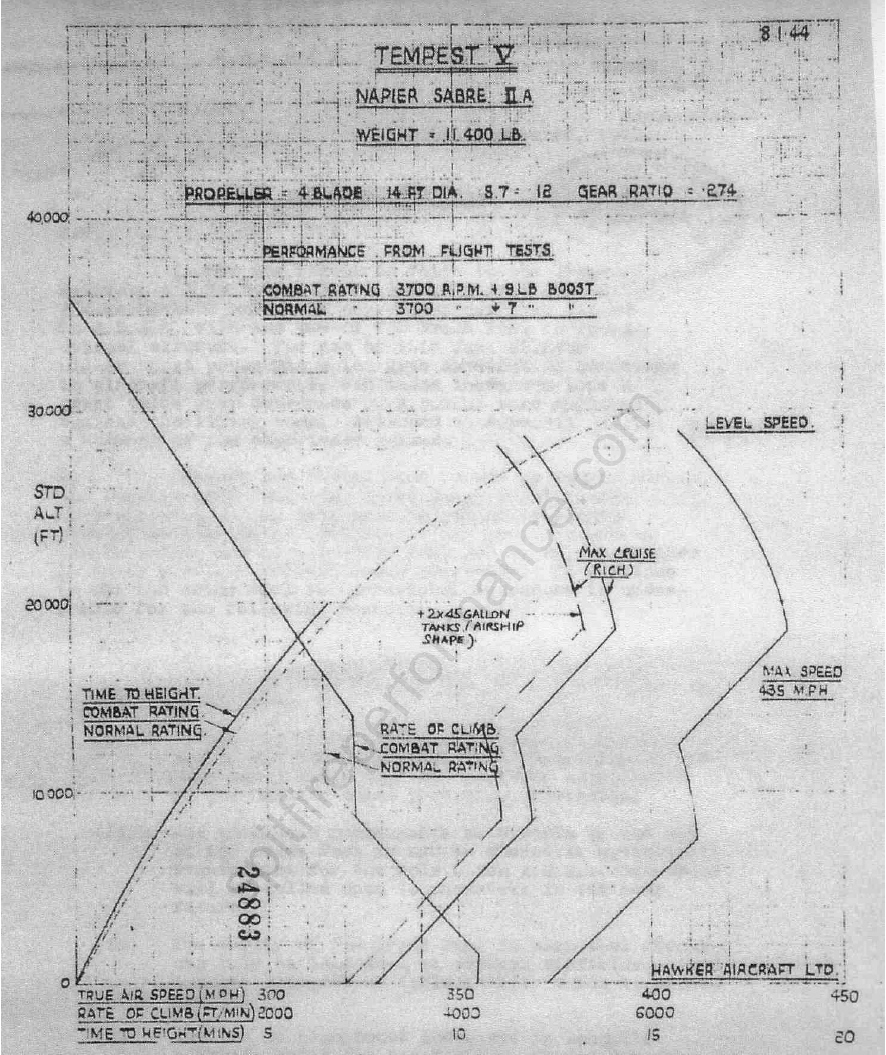 But very shortly thereafter, to deal with the V1's, the decision was made to increase boost on the Sabre IIA to +11 when it was operated with 100/150 octane fuel, which raised available HP to 2420. 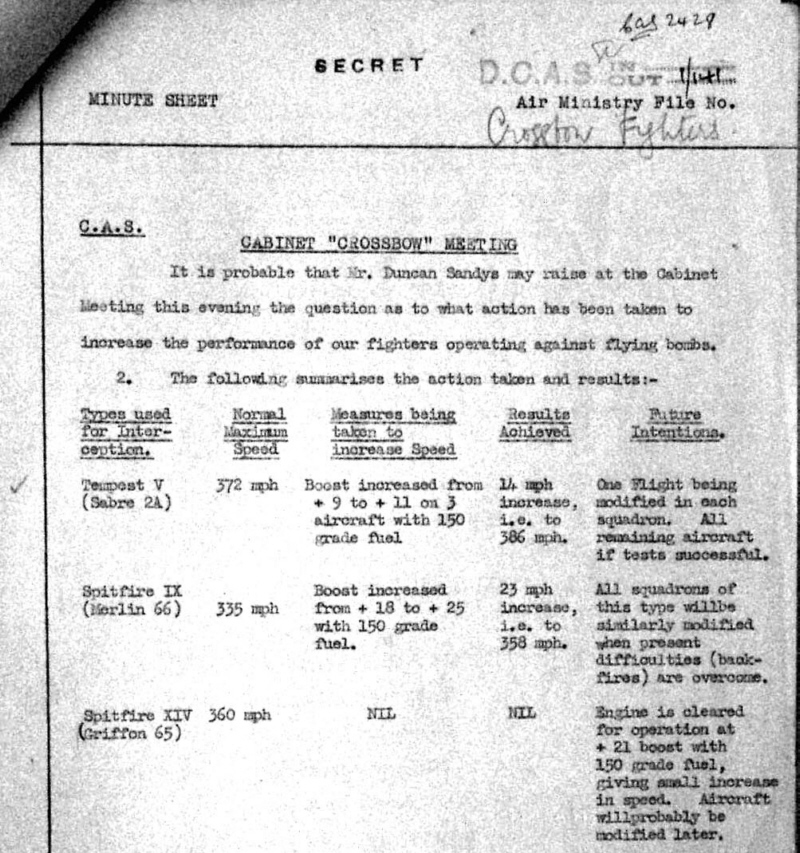 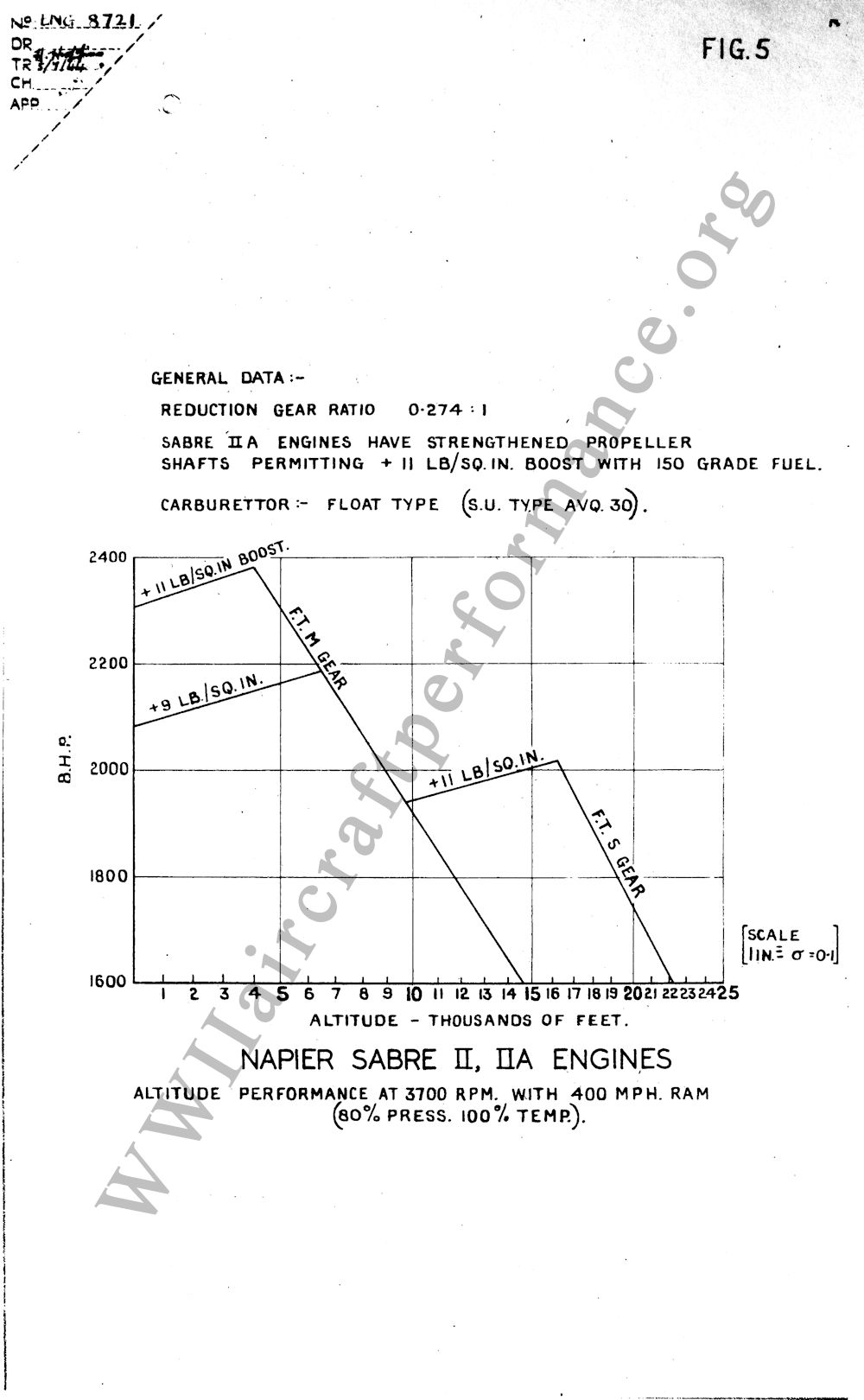 All subsequent Tempest production batches were equipped with the Sabre IIB and delivered from the factory rated to +11 boost even with 100/130 fuel. In the field, after December of 1944, when 100/150 octane fuel became available on the continent, maximum allowable boost was increased to +13, which raised HP to 2600. The following charts show Tempest tested speed at +12 boost: 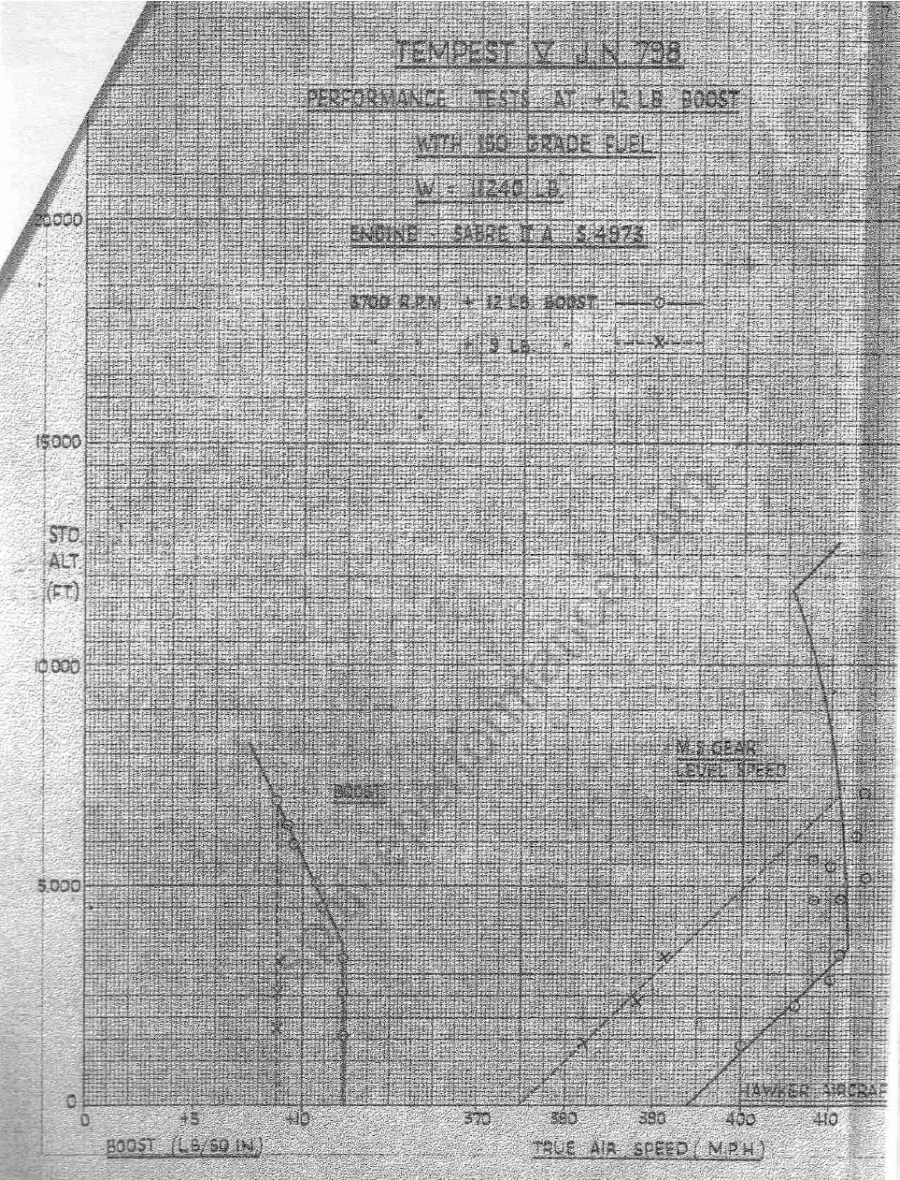 or +11 boost when the aircraft had been cleaned up and waxed, with pods for drop tanks removed: 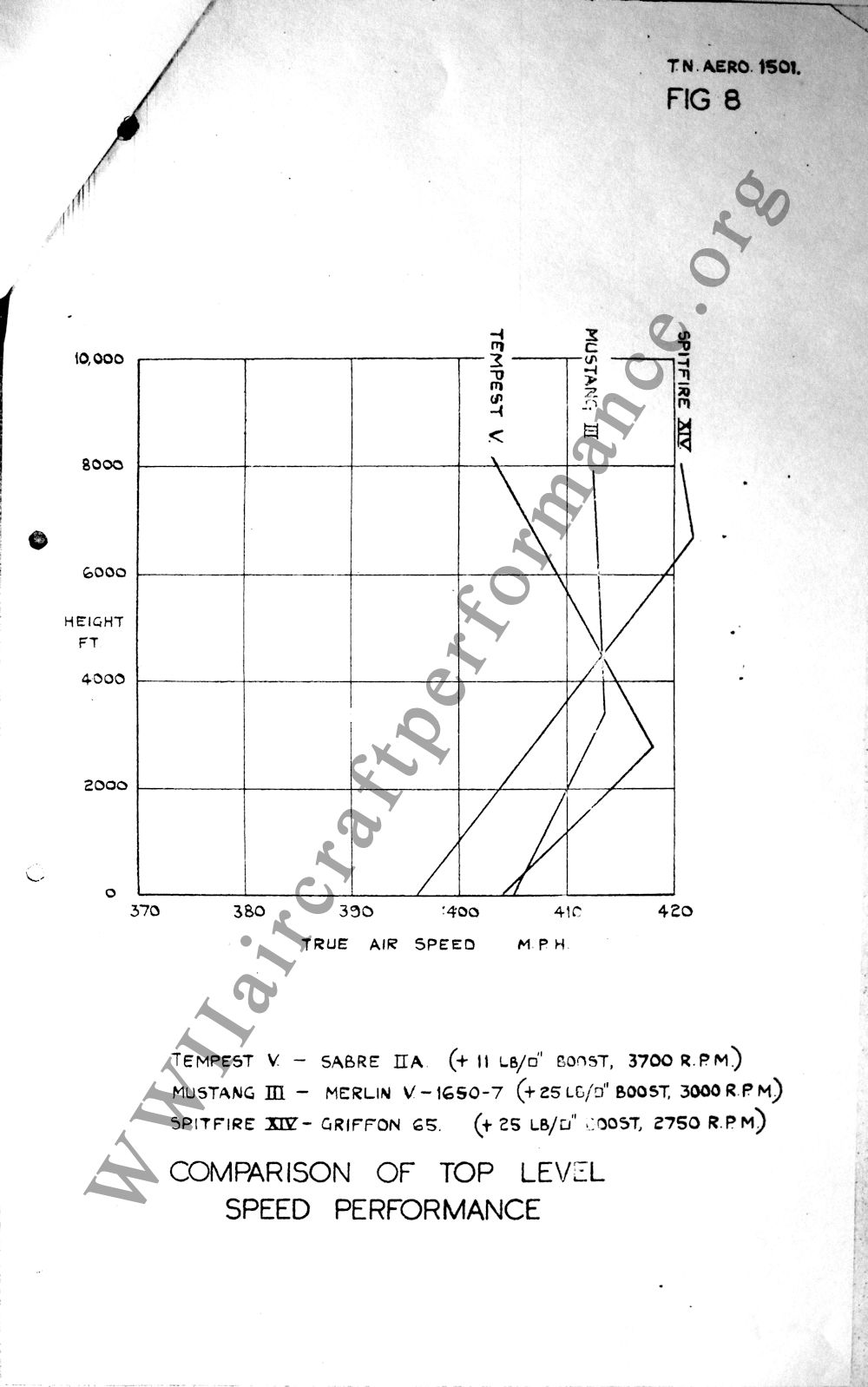 All tables from Mike Williams Aircraft Performance site: http://www.spitfireperformance.com/spittest.html |
|
#27
|
|||
|
|||
|
Quote:
All together is was quite unlike any plane Tempest pilots would have previously flown and low level flying also required some considerable experiance. |
|
#28
|
||||
|
||||
|
We speak about less powerfull version of Tempest in game but what about overspeedy Fw 190 D-9 (44) ? I found playing online servers that most popular planes Fw 190 D-9 is much more faster at full throttle altitude then it should. I searched data about D-9 maxium speed and i found maximum reported speed of D-9 version with C3 fuel is 705 km/h TAS at 5,5 km. I tested D-9 (44) in game (Crimea map, 12:00, 100% fuel) and i reached constant speed 728 km/h TAS at 5.5 km. I also checked Il2Compare where is the same maximum speed as i reached in game. So D-9 (44) in game is faster at 23 km/h then RL best speed for D-9.
So we have very poular in online servers Fw190 D-9 (44) which beside of is the higher RL boost D-9 version but is faster then should and other hand we have allied planes like P-51 and Tempest which are accurate in maximum speed performance. These give the Dora flyiers speed adventage which shouldnt have. |
|
#29
|
|||
|
|||
|
Quote:
http://tempest.nerdnet.nl/handlv.pdf Stall speed was 85 mph/136 kph in clean condition, 75 mph/120 kph with flaps and undercarriage down. Final approach speed was 100 mph/160 kph with the flaps down. High speed stalls, as per any aircraft, happened if the elevator was applied too strongly, but there was warning with a wing dropping first, and departure only occurring with continued force was applied to the elevator. Recovery was described as "immediate", if the elevator was released. And Tempest pilots had most often previously flown the Typhoon, which had very similar torque and takeoff characteristics. |
|
#30
|
|||
|
|||
|
Kwiatek: We also have, on those very same df servers, Spitfires that do not lose speed in turn at all, and that are therefore over-used... Its not so rare, even on spit vs 109, that of 40 guys flying red 35 are on Spit... Besides, the D9 "early" can always be replaced with D9 "late" - SpitIX 25lbs to MK. V, anyone?
|
 |
|
|